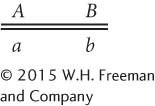Notation for Crosses with Linkage
In analyzing crosses with linked genes, we must know not only the genotypes of the individuals crossed, but also the arrangement of the genes on the chromosomes. To keep track of this arrangement, we introduce a new system of notation for presenting crosses with linked genes. Consider a cross between an individual homozygous for dominant alleles at two linked loci and another individual homozygous for recessive alleles at those loci (AA BB × aa bb). For linked genes, it’s necessary to write out the specific alleles as they are arranged on each of the homologous chromosomes:

In this notation, each horizontal line represents one of the two homologous chromosomes. Inheriting one chromosome from each parent, the F1 progeny will have the following genotype:

Here, the importance of designating the alleles on each chromosome is clear. One chromosome has the two dominant alleles A and B, whereas the homologous chromosome has the two recessive alleles a and b. The notation can be simplified by drawing only a single line, with the understanding that genes located on the same side of the line lie on the same chromosome:

This notation can be simplified further by separating the alleles on each chromosome with a slash: AB/ab.
Remember that the two alleles at a locus are always located on different homologous chromosomes and therefore must lie on opposite sides of the line. Consequently, we would never write the genotypes as

because the alleles A and a can never be on the same chromosome.
It is also important to always keep the same order of the genes on both sides of the line; thus, we should never write

because it would imply that alleles A and b are allelic (at the same locus).